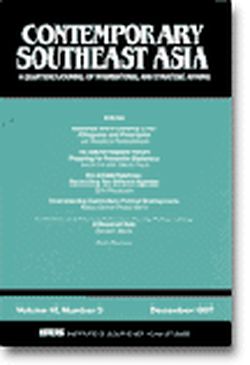Contemporary Southeast Asia: A Journal of International and Strategic Affairs Vol. 15/3 (Dec 1993)

Date of publication:
December 1993
Number of pages:
108
Code:
CS15/3
Contents
-
Preliminary pages
- ARTICLES
-
Pacific Century: Myth or Reality?, by Morton Abramowitz, author see abstractThe notion that the twenty-first century will be the century of the Pacific has been around for some time now. It is a notion which is both myth and reality at one and the some time. This article looks at both the myth and the reality of the issue. It examines the extent to which today's vibrant Asian economies sufficiently equip the countries of the Asia-Pacific for a leadership role, in more than just economic terms, in the century to come. It contends that the next century cannot simply be Asian.
-
Indochina and ASEAN: Seeking a New Balance, by Michael Leifer , author see abstractThe new relationship in place between Indochina and member countries of the Association of Southeast Asian Nations (ASEAN may be regarded as a solution to yesterday's problems and not today's. This new balance in the relationship cannot in itself provide a sufficient basis for a post-Cold War security order in Southeast Asia. The attendant change in the regional strategic context means that the question of security has to be addressed within a wider East Asian framework. That need has been recognized in the initiative taken for a wider multilateral security dialogue at the meeting of ASEAN's Foreign Ministers in Singapore in July 1993. This promising development extends geographically the ASEAN security model based on conflict management and avoidance. But that model has never been intended to cope with the problem of power in regional relations for which more robust provision is required than an extended structure for confidence-building.
-
Why Hasn't Vietnam Gained ASEAN Membership?, by Hoang Anh Tuan, author see abstractNot long ago, it would have been impossible to imagine the current rapprochement between Vietnam and the ASEAN countries. Changes in the global and regional environment, as well as in the policies of Vietnam and the constituent ASEAN members are the main reasons for the improvement. Stimulated by ASEAN's success, Vietnam has shown its interest in joining the Association. Among the ASEAN countries, Indonesia and Malaysia have positively supported Vietnam's proposal, but ASEAN, as an organization, has not yet reached consensus on the issue. This article analyses some underlying reasons for the hesitations among the ASEAN countries and discusses Vietnam's main preoccupations.
-
Patterns of Chinese Political Participation in Four ASEAN States, by Leo Suryadinata, author see abstractThere is formal and informal political participation among the Chinese in the ASEAN states. Formal political participation has occurred, among other ways, through ethnic party (for example, in Malaysia), multi-ethnic party (for example, in Singapore) or "assimilated political party" (for example, Soeharto's Indonesia and the Philippines) processes. Informal participation, on the other hand, includes activities in non-political organization and pressure groups. However, patterns of political participation by the Chinese has differed from country to country depending on the nature of the state and the size of the Chinese community. In reality, there is always a combination of one type of formal participation and informal participation.
-
The Dilemmas Facing Australia's Defence Policy, by Gary Maurice Brown, author see abstractThis article identifies three problems which, it argues, are insufficiently recognized by Australian defence planners, and which tend to undermine the credibility of Australia's declared policy of regional engagement. These problems, or dilemmas, are: the declining value of the Australian-American alliance; the inadequate state of Australian defence self-reliance, including the poor prospects for Australia's defence industry; and the consistent failure to meet previously announced defence expenditure targets. The article suggests that Australian defence policy has taken insufficient account of the regional consequences of the end of the Cold War, and that this failure has had adverse effects - in particular, on the Defence Deportment's programme to substantially increase defence-related exports.
-
Will Financial Crisis Lead to Doctrinal Renaissance for the U.S. Navy?, by Stephen Law Ryan, author see abstractDeep cuts about to be made in American carrier battle groups (CVBGs) are causing considerable alarm among Asian nations which count upon American military support. Yet this concern s misplaced. CVBCs are too big and cumbersome to be used in the sort of littoral ocean warefare most likely to occur in this region. At the same time, today's precision-guded munitions may offer a better alternative, as they can be launched at greater range and with less risk from smaller and less costly formations. Furthermore, the growing threat to an assembled amphibious force from total ballistic missiles is one which is best handled by ship other than a carrier. Therefore, the current CVBC holiday imposed on the U.S. Navy s a blessing, a chance to retire outdated systems and plough the funds back into a new generation of warships and weapon systems better able to serve the interests of the United States and its allies.
- BOOK REVIEWS
-
BOOK REVIEW: Reinventing Vietnamese Socialism: Doi Moi in Comparative edited by William S Turley and Mark Selden, by Russell Hiang-Khng Heng, author
-
BOOK REVIEW: Mirror on the Wall: Media in a Singapore Election by Eddie C Y Kuo, Duncan Holaday and Eugenia Peck, by Khong Cho Oon , author
-
BOOK REVIEW: Singapore Changes Guard edited by Garry Rodan, by John Girling, author






